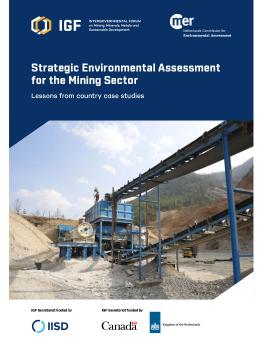
Strategic Environmental Assessment for the Mining Sector
Lessons from country case studies
An essential tool for policy-makers working to develop a sector-wide vision for responsible mining.
This report provides analysis and case studies that highlight how strategic environmental assessment (SEA) can improve mining sector governance.
Not to be confused with environmental and social impact assessments (ESIA), which apply to individual projects, SEA applies more broadly and is defined by the OECD as a range of analytical and participatory approaches that aim to integrate environmental considerations into policies, plans, and programs, and evaluate the interlinkages with economic and social considerations.
SEA can improve mining governance by
- providing better insight into environmental, economic, and social trade-offs, increasing the likelihood of positive outcomes;
- raising awareness about unsustainable development options to prevent costly mistakes and conflicts;
- increasing understanding of the cumulative impacts of multiple smaller developments and the opportunity to improve the coherence between projects;
- enhancing credibility of government decisions, leading to more public trust in the planning process and more support for plan implementation.
Participating experts
You might also be interested in
Leveraging Digital Infrastructure for Mining Community Resilience
This report explores the socio-economic impacts and potential of new technologies in the mining sector.
IGF Case Study: Decarbonization of the Mining Sector
Case studies from Chile, Indonesia, and South Africa that delve into the role of the mining sector in efforts to reduce greenhouse gas (GHG) emissions.
2023 IGF Annual Report
Detailing an eventful year that saw the IGF Secretariat deliver several new publications, workshops, and events for its growing membership.
What Makes Minerals and Metals "Critical"?
Exploring how governments define what should be considered as "strategic" or "critical" based on a series of objective criteria.